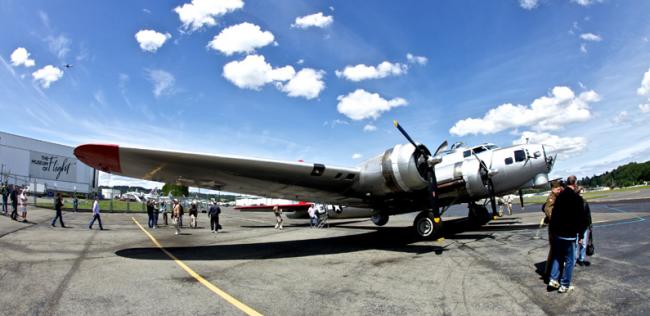B-17 returns to Tukwila as veterans reminisce
"Aluminum Overcast," a restored B-17 World War II bomber, sits on the airfield next to Tukwila's Museum of Flight.
Tue, 06/01/2010
As the midday sun shone over Tukwila's Museum of Flight, "Aluminum Overcast" took to the skies once again. A restored B-17 bomber that narrowly missed action in World War II, the plane was in Tukwila last week as part of its "Salute to Veterans" tour.
Aluminum Overcast tours the country with the Experimental Aviation Association (EAA), and the Cascade Warbirds chapter of the EAA.
For "Aluminum Overcast's" first flight from the museum, several World War II Air Corps veterans were on hand to discuss their flight experiences with reporters.
They included Bill Holloman III, a member of the famed Tuskegee Airmen. His training at Tuskegee began in 1942, and he entered combat in 1945.
"I like to say I ended the war," he quipped. Despite the brevity of his stint in Italy, he escorted numerous bombers and performed fighter sweeps and strafe emissions, flying primarily P-51's.
He noted that he had flown all of the fighters used in the area, and said that his favorite aircraft was "whichever I'm going to get to fly next."
Only 19 years old, he was among the youngest pilots serving in Italy at the time.
After WWII he continued to serve in the armed forces, flying in the Korean War and the Vietnam War, performing airborne hurricane research in 1947 and working with a B-17 air rescue squad in the 1950's.
Today, Holloman serves as a historian and researcher for the Washington State chapter of Tuskegee Airmen, Inc., an organization devoted to preserving the group's legacy and introducing future generations to aviation and science.
Another WWII veteran well acquainted with B-17's present at the flight was Bob Fox, who maintained "every (plane) used in the European theater."
Between 1943 and 1946, Fox worked on the electrical systems of planes in Switzerland. His crew retrieved planes and returned them to working order, in addition to repairing planes damaged in combat. Heavy German use of flack complicated attempts to find the damage after confrontations.
His most exciting task, though, was one that historians have never officially recorded.
"I worked on a secret project building a remote controlled bomb," he said.
Constructed from a jury-rigged B-17, the craft had to breach the thick concrete walls of a German submarine pen. About a third of the plane's electrical systems had to be removed and others significantly altered to allow the "flying bomb" to destroy the submarines.
To this day, Fox says, the government has not acknowledged that the project existed.
Leonard Scott, also present at the flight, said that he has "always been fascinated by airplanes," which led him to take his children to air shows at McChord Air Force Base. This early exposure to flight inspired his daughter Kimberly Scott to attend the Air Force Academy and work for a time as a pilot with Alaska Airlines.
She has served with the Air Force for almost 20 years, currently flying C-17's out of McChord Air Force Base as a reservist, and she is active in the Washington chapter of Tuskegee Airmen, Inc.
Aluminum Overcast will remain at the Museum of Flight until May 31st, with several other locally owned vintage planes arriving on May 29th. Half-hour long historic flight experiences may be scheduled in advance for $359 for EAA members, or $399 for non-members, at 1-800-359-6217, and the plane will be available for self-guided tours after it has finished its flights each day.
Explaining why the EAA tours conducts aircraft tours, EAA member Bob Prior gestured towards Bill Holloman, calling him "the reason we're here." Prior said that the mission of the EAA tours is to "bring the airplane to the people and honor the veterans."


